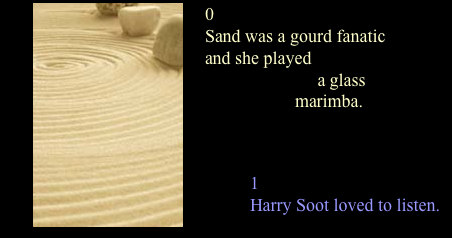The Ballad of Sand and Harry Soot
A hypertext ballad metaphorically exploring the relationships between people (Harry Soot) and machines (Sand).
Sand's relation to dreams bears repeating./ Was it mentioned?
Harry Soot lived to listen.
HTML
Included in the print-and-CD publication Zone : Zero, as noted below, and published in print in the Boston Review.
When it was selected by Heather McHugh for the Boston Review Poetry Prize, McHugh's introduction was as follows:
A very odd love song, constructed around the figures of Sand and Soot, manages in ten inventive yet coherent pages to spin some astonishing variations on its theme. Sand and Soot are considered as elements, as temperaments, as linguistic fields, as harmonic fields, as shimmers and shades. One would think the possibilities exhaustible in a few pages, but this poet keeps deepening the premises of an inspired polarity. Everywhere the ranges of reference are generous—through binary numbers, physics, history, economics, medicine, magic, music. At times the poem seems to be made of brushstrokes, at times of whole notes—or maybe hemi-demi-semiquavers. When “Tell’s weapon” appears just two words away from the word “inscription,” we are sufficiently wised-up not to miss the meta-poetics of this love tale.
Not least important are the licks of wicked humor at work in this peculiar courtship of Sandwoman and Sootman. And when, her in dotted-Swiss shift, “Sand could be retro,” the reader is ready to supply the senses of the “spect”: for these are pointillistic figures—figures of perception and imagination, figures of time and its escapees; one transparent, one opaque; one originating, one completing. It would be all too tempting to make a simple binary opposition out of them, but the poet is far too canny for such reductions. One of the poem’s great virtues is its capacity to send off from its original premises more and more shooting stars of wild association, while never belaboring the host of fundamental—yet sometimes just delicately implicit—relations: relations that arise in the mind, over the course of a sympathetic reading, as spectres of near and distant fires, glasses (mirrors, microscopes, telescopes), sandmen, time-keepers, dreamers, and dreaders. All the while the masquerade manages to keep two living lovers at heart: in a world of Metro cards and movies, aircraft carriers and chemical peels, they’re nothing if they’re not contemporary, too.
Time and timelessness are equally the premises of poetry, and virus has an etymological kinship with life itself. The thinker makes much of numbers, and the lyricist of love, but the mind is also a dreamer and the heart a ticker: dot dot dot, dash dash dash, dot dot dot. The point of this poem is many points, moved by fondness, funniness, fatality: a wheel of words, a wind that darts us, whirl of real stardust.
—Heather McHugh



